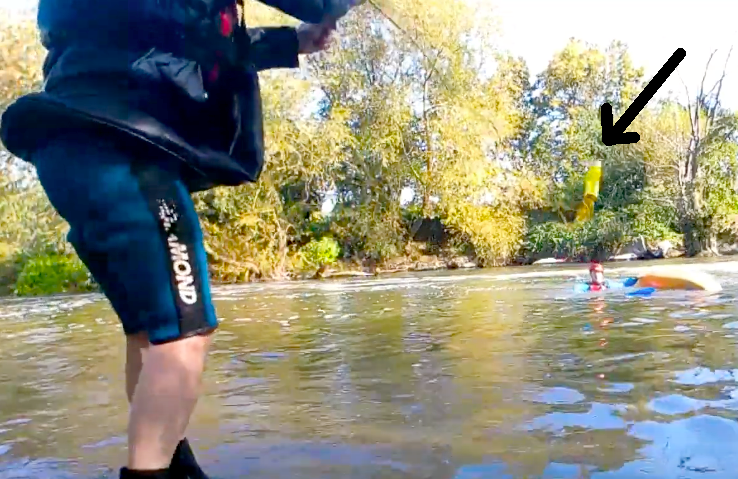River rescue using a throw line
Your throw line is an essential part of your equipment and helps with rescues on flat and moving water. To be used successfully, you must know how to throw it and, of course, practice throwing it.
Practice Tip: Go to your local park, put down a marker and practice throwing the line to land on or across the marker. The more you do, the better you get.
A throw line is used to tow a swimmer to the shore or river bank and removes the need for you to enter the water.
Obvious - take your throw line with you on every trip!
 Throwing a line to Ed - right on target
Throwing a line to Ed - right on targetIt's made up of two
parts. The rope and the bag. The rope can vary in length and is commonly 10 to
15 metres in length.
The rope is brightly coloured to make it visible in the water. The bag is large enough to hold all the rope and again, bright in colour. It may have a padded end to help it to float in the water.
Using a throw line is done in two parts - the release and the tow.
The release requires that the bag full of the rope is held in the throwing hand (depending whether you are left or right hand) and a small amount of rope is held in the other hand. To start, the bag is opened and a small length of rope taken out like this.
The best stance to adopt before throwing is with one leg slightly forward of the other leg - ie. maximum stability.
A swing action of your throwing arm generates momentum for the bag and rope. At the point when the arm is straight and pointing towards the swimmer, the bag is released.
Allowances may need to be made for river currents, obstructions (trees, rocks, bridges etc) and surface wind.
Wind can be a big issue especially when the last metres of rope are exiting the bag. The bag is significantly lighter at this point and therefore more susceptible to deflection from the wind.
The weight of the bag and rope propels it towards the swimmer and hopefully reaches them.
CRITICAL >>> The other end is held firm in the hand to ensure it does not go with the rest of the rope and bag.
Once the swimmer has held on to the bag and/or rope, the line can be pulled back to shore and the swimmer towed in. At all times, both the swimmer and rescuer must not permanently attach the rope to the themselves. Both parties must be able to release the rope to avoid entanglement.
Ideally, the swimmer should be on their back with the rope fed over their shoulders towards the rescuer. A steady and consistent pulling on the rope is best to make the tow as smooth as possible and avoid the swimmer going under water.
Pulling them on their front is possible if the rope is kept low in the water by the swimmer and their head held as high above the water as they can.
As the swimmer approaches the bank or shore, they can be assisted to land.
The line is never permanently attached to either the rescuer or swimmer and can be released if needed. This is essential if the line gets caught on something or the swimmer is panicking and pulling on the rope. In these situations, you must never be scared to let go of the line. Your safety is paramount and you must not be pulled into the water or trapped by the line.
The correct use of a throwline can be remembered using the acronym SATTA. It is short for:
- S = Shout to alert the swimmer and tell them what is going to happen next. For example, 'Hey! Keep watching me, I'm going to throw a rope to you'.
- A = Attention - wait until the swimmer is focused on what you are about to do. This maximises the chances of them catching the line especially in white water.
- T = Throw the line towards the swimmer with enough power and accurate aim to reach them first time.
- T = Tow the swimmer towards the shore avoiding further hazards.
- A = Assist the swimmer on to land and continue rescue, call for help and/or start first aid if needed.
Regularly practicing to throw the line gives you a head start in any rescues and increases the chances of the bag and rope reaching the swimmer first time.
Re-throwing a line and bag after it has uncoiled is possible, but much more difficult and can be less accurate. A first time strike is the best outcome when using a throw line so practice, practice, practice!
In all water rescues, entering the water must be the last resort. This is why the throw line is such an important part of your rescue equipment.
Carrying it with you gives you a powerful way of providing rescue to any swimmers you might encounter.
Good luck and happy - safe - paddling.
See the video below for your throw line instructions:
PS. Paddlesports can be dangerous.
Read our safety disclaimer - here

New paddling inspiration, tip, trip or technique video EVERY week! Watch Ed, Dave and Moo on their kayaking, canoe and SUP adventures. It's all about safely having fun on the water. 200,000+ views, 110+ videos & 900+ subscribers so far! Click below to start watching:
Ed & Dave Kayaking Youtube Channel
WANT TO HELP US?
We really value your visit to us today. We run this website and our Youtube channel to provide paddling inspiration, tips, trip and technique content to you. We love being out on the water! If you enjoyed your visit, you can support us by using the links below:
Buy us something on our wish list
Thank you
NEED WEB HOSTING?
We recommend IONOS. Great service, technical support and stable hosting. Click the link below to find out more:
IONOS Web Hosting - RECOMMENDED!



